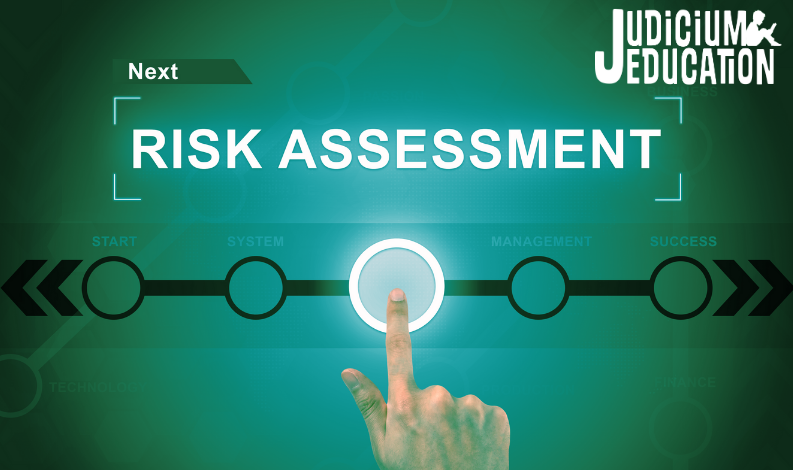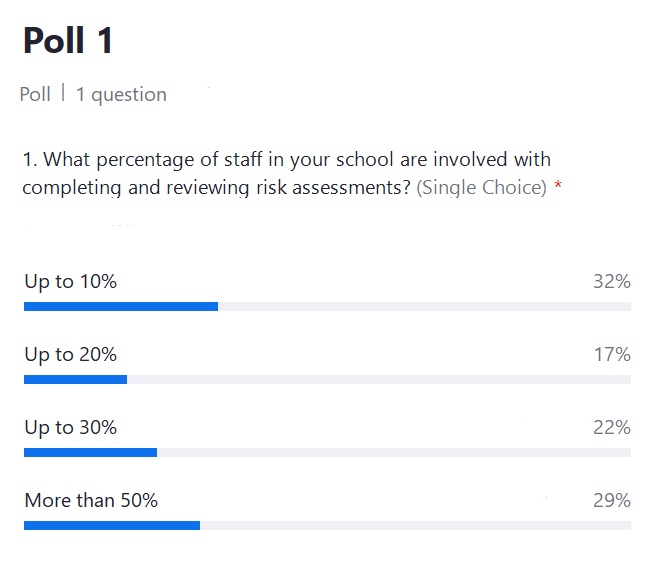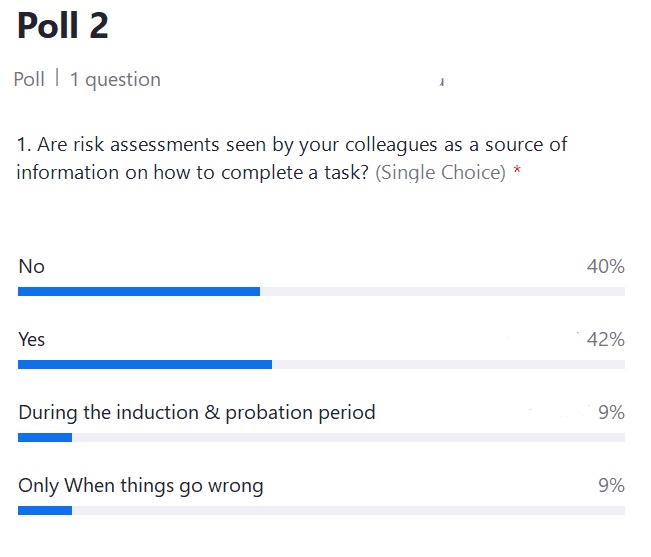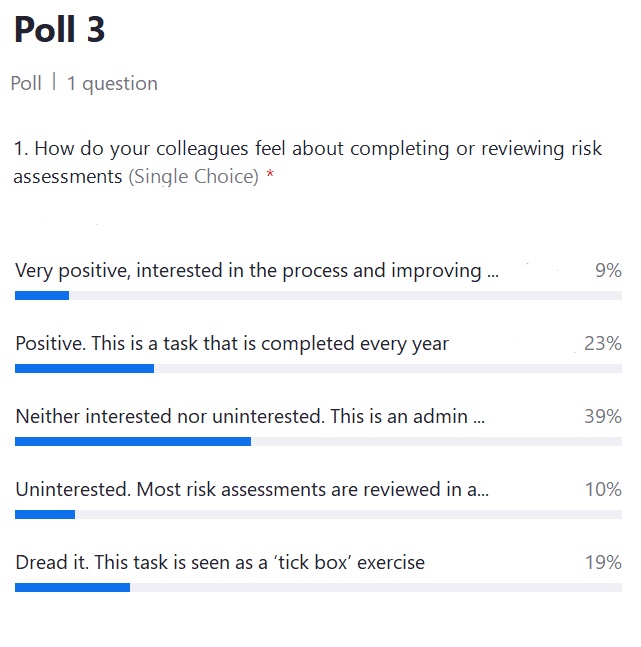
This summary is based on Judicium’s Health and Safety ‘Sofa Session’ from the 14th of June, with our resident expert Isthar Pearce CMIOSH.
This session focused on why risk assessments are a legal requirement, making risk assessments work for you, and five key takeaways on completing risk assessments.
Poll 1

Why are risk assessments a legal requirement?
The Health and Safety at Work etc Act 1974 sets out the requirements of employers for ensuring the health and safety and welfare of their employees. It is the primary legislation governing occupational health and safety.
Most health and safety regulation is based on the requirement to complete risk assessments (RAs). They are a tool to assess risk and to set up the correct control measures to mitigate against that risk.
If there was a civil claim for personal injury, a copy of your risk assessments would be required and can be used to defend against a claim. Furthermore, the Health and Safety Executive (HSE) may decide to investigate any accidents in your school or Trust and would request to see the relevant RAs.
Polls 2 and 3
Making risk assessments work for you
Training and creating a health and safety culture in school.
Risk assessments are a great management tool. Although RAs take time, they will help you identify risks and what controls or resources are required to eliminate or reduce them. However, you can’t manage what you don’t know.
All staff responsible for writing risk assessments should be trained on how to complete them. Other members of staff should be able to understand the RAs that apply to their work activities. This could be a toolbox talk or eLearning module, but it is helpful for all members of staff to have a basic knowledge of risk assessments. This also helps to instil a health and safety culture within your school, and helps staff see the purpose of RAs rather than simply seeing them as a ‘tick box’ activity.
A ‘competent person’ should complete the RA. We recommend they do this with the help of colleagues who have knowledge of the area. For instance, you may have a head of D&T working with the Food Tech teachers, discussing their curriculum and tasks to accurately complete an RA for a new course offering.
The more viewpoints you can include helps mitigate subjectivity when assessing risk. Furthermore, there is no one size fits all template for risk assessments. They are dependent on the specific needs and uses of your school or site and their format will change to reflect this.
Utilising the HSE 5 Steps to Managing Risks
- Identify Hazards
- Take an in-depth look at your site.
- Ask yourself: How are classrooms used and what objects/substances are present? How do spaces change throughout the year? What practices (safe or unsafe) have you seen?
- Check past accident reports to identify past risks and current controls.
- Always remember you are thinking about staff, contractors, visitors, volunteers, etc.
- Assess the Risks
- Decide how likely the hazard is to cause harm and how serious that harm could be.
- Detail what you are doing to control the risk and any further action you may need to implement.
- Control the Risks
- Can you eliminate the risk?
- If not, are there further measures you can take to reduce the risk?
- You're not expected to eliminate all risks, but you need to do everything 'reasonably practicable' to protect people from harm.
- Record your Findings
- You must record: the hazards, who might be harmed and how, and what you are doing to control the risks.
- Judicium recommends keeping a risk register to organise your risk assessments.
- Ensuring this register is accessible to your staff is another way to create a proactive culture within your school.
- Review the Controls
- Your risk assessments should be live documents that change in accordance with your school and its needs.
- Any time there has been a change, you should be reviewing the RA. Schools are unique in that a new cohort joins each year, the use of sites and buildings may change throughout the year and employees and their roles may shift.
- We recommend reviewing RAs annually if there have been no changes.
A good RA can show your compliance with legislation and shows key stakeholders how your school or Trust values and manages health and safety at your organisation.
5 key takeaways for completing risk assessments
- Involve at the very least two (ideally three people) in writing and reviewing RAs.
- Ensure that all those who carry out the tasks are consulted and fully understand the control measures.
- Avoid generic terms such as PPE, reasonable, suitable, or adequate. Instead, briefly detail what is required.
- Also, avoid ambiguous terms such as ‘Staff should wear PPE’ and instead use ‘Staff wear latex-free gloves.’
- Avoid using ambiguous terms such as ‘should’ or ‘could.’
- Ensure risks are effectively evaluated.
- Consider how somebody could be injured and the severity of the injury.
- For instance, most people are aware that asbestos and electricity can kill, so these are always deemed high risk. However, we also know having effective controls reduces the risks to a reasonable level.
- Have a risk assessment register so you and everyone in your school can quickly identify what areas have been assessed.
Additional Info:
HSE Managing Risks and Risk Assessment at Work
The Health and Safety Service provides accredited training courses, including Risk Assessment eLearning with school specific modules ranging from courses designed for premises managers and SLT to all staff offerings and fire warden training: https://www.judiciumeducation.co.uk/elearning
We also offer live, exclusive training options https://www.judiciumeducation.co.uk/training#Scheduledtraining_HealthSafety
To review Judicium’s forthcoming sofa sessions please click here.
Follow us on Twitter - @JudiciumEDU
© This content is the exclusive property of Judicium Education. The works are intended to provide an overview of the sofa session you attend and/or to be a learning aid to assist you and your school. However, any redistribution or reproduction of part or all of the contents in any form is prohibited. You may not, except with our express written permission, distribute or exploit the content. Failure to follow this guidance may result in Judicium either preventing you with access to our sessions and/or follow up content.
Related content
.png)
This blog is based on Judicium’s Health & Safety and SEND session on 26th November with resident expert India Cottenden
.png)
This blog is based on Judicium’s Food Safety Sofa session on 12th November with resident experts Sue Roberts and Tracey Killick

This blog is based on Judicium’s Health and Safety ‘Sofa Session’ on the 15th of October, with our resident expert Mike Wright.

This prestigious award celebrates our commitment to delivering expert, education-specific Health & Safety support that lifts the burden for school teams while raising safety standards across the sector.

This blog is based on Judicium’s Health and Safety ‘Sofa Session’ from 18th June, led by resident expert , Mike Wright, CMIOSH. This session focuses on the control of substances hazardous to health (COSHH) and their relevance in school settings, how assessments should be undertaken and what staff could be at risk.

Discover why Judicium has been shortlisted for Fire Safety Consultancy of the Year at the 2025 FSM Awards, recognising our expert support for schools and trusts in delivering sector-specific, compliant, and practical fire safety solutions.



Sofa Sessions | H&S